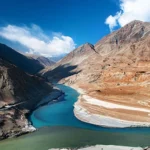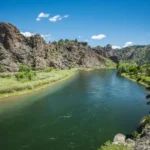
The Mariana Trench, the deepest part of the world’s oceans, is a place of profound mystery and wonder. Located in the western Pacific Ocean, this immense underwater canyon holds many secrets within its crushing depths. From unique geological formations to extraordinary marine life, the trench challenges our understanding of Earth’s extreme environments. Below are some fascinating facts that shed light on this enigmatic abyss.
Deepest Point on Earth: The Mariana Trench, situated in the western Pacific Ocean, east of the Mariana Islands, is renowned as the deepest oceanic trench and the deepest known point on Earth. This crescent-shaped trough spans approximately 2,550 kilometers (1,580 miles) in length and 69 kilometers (43 miles) in width. Its immense depth results from the subduction of the Pacific Plate beneath the smaller Mariana Plate. This geological feature is a significant area of interest for oceanographers and geologists due to its unique properties and the extreme conditions found within its depths, which challenge our understanding of the Earth’s biosphere and geology.
Crushing Depths: The Mariana Trench’s deepest recorded depth is an astounding 11,034 meters (36,200 feet), a measurement obtained in 2011 by the robotic submersible Nereus. This depth is almost three times the height of Mount Everest. At such depths, the trench represents one of the most extreme environments on Earth, with conditions vastly different from those on the surface. The pressure here is incredibly high, posing significant challenges to exploration. The Nereus’s descent provided valuable data on the trench’s physical characteristics, expanding our understanding of deep-sea environments.
Challenger Deep: The Challenger Deep is the deepest known part of the Mariana Trench and the Earth’s oceans, named after the HMS Challenger, a British Royal Navy survey ship that conducted the first scientific investigation of the trench in 1875. Although their measurements were not as precise as today’s, they marked a significant milestone in oceanography. The Challenger Deep plunges to depths of around 10,994 meters (36,070 feet) according to more recent and accurate measurements. This area has since become a focal point for deep-sea exploration, drawing numerous scientific expeditions aiming to uncover its secrets.
Mount Everest Comparison: To grasp the immense depth of the Mariana Trench, one can imagine placing Mount Everest, the tallest mountain in the world at 8,848 meters (29,029 feet), into the trench. Even then, the peak of Everest would still be submerged by over 2,000 meters (6,561 feet) of water. This visualization helps convey the scale of the trench, emphasizing the incredible depths reached within the ocean. Such comparisons highlight the vast differences between the Earth’s highest and lowest points, providing a stark illustration of the ocean’s depth.
Pressure Cooker: At the bottom of the Mariana Trench, the pressure is a staggering 108.6 MPa (15,750 psi), which is approximately 1,500 times greater than the atmospheric pressure at sea level. This immense pressure, equivalent to the weight of 1,600 elephants standing on a single square inch, makes human exploration extremely challenging. Only specially designed submersibles, such as the Trieste and Nereus, can withstand such conditions. The study of organisms living at these depths, known as extremophiles, offers insights into the adaptations required to survive under such extreme pressure.
U.S. Flag Down There: In 1960, the bathyscaphe Trieste made history by descending to the Challenger Deep, carrying a small U.S. flag. This mission, led by Swiss oceanographer Jacques Piccard and U.S. Navy Lieutenant Don Walsh, marked the first manned expedition to the deepest point on Earth. The flag symbolized human achievement and exploration spirit. Spending about 20 minutes at the bottom, Piccard and Walsh gathered valuable observations, though visibility was limited. This mission paved the way for future deep-sea explorations and demonstrated the feasibility of reaching the ocean’s most remote regions.
Waterfalls…Underwater?: In 2011, scientists discovered unique underwater waterfalls within the Mariana Trench. These waterfalls are formed by brine pools, which are areas of highly saline water that are denser than the surrounding seawater. These dense brine pools cascade down the trench walls, creating an underwater waterfall effect. This phenomenon occurs because the salinity differences cause the denser brine to sink, flowing over the trench’s features. These brine waterfalls are fascinating examples of the complex and dynamic processes occurring in deep-sea environments, contributing to the trench’s unique ecosystem.
Life in the Extreme: Despite the extreme pressure, darkness, and cold temperatures of the Mariana Trench, life thrives there. Organisms known as extremophiles have adapted to these harsh conditions. These include single-celled organisms, such as bacteria and archaea, and more complex life forms like amphipods and certain species of fish. These creatures have unique adaptations, such as flexible membranes and specialized enzymes, allowing them to survive and thrive. Studying these organisms helps scientists understand the limits of life on Earth and provides clues about the potential for life in similar extreme environments on other planets.
Temperature Surprise: The temperature at the bottom of the Mariana Trench is near freezing, typically ranging from 1 to 4°C (34 to 39°F). While this is extremely cold, it’s not the coldest ocean environment, as polar regions can experience even lower temperatures. The near-freezing temperatures, combined with the high pressure and lack of light, create a challenging environment for life. However, the presence of hydrothermal vents along the trench walls introduces some warmer, mineral-rich waters, supporting unique ecosystems that rely on chemosynthesis instead of photosynthesis.
Volcanic Activity: The Mariana Trench is part of a geologically active zone, characterized by significant volcanic and tectonic activity. Hydrothermal vents, where seawater seeps into the Earth’s crust, is heated by underlying magma, and then expelled, are found along the trench’s walls. These vents release hot, mineral-rich fluids, creating unique ecosystems that support life forms relying on chemosynthesis. The volcanic activity in the area also contributes to the formation of unique geological structures, such as underwater mountains and volcanic islands, making the trench a dynamic and constantly changing environment.
Unique Rock Formations: The Mariana Trench features unique rock formations shaped by the immense pressure and geological activity over millions of years. The rocks and sediments have been compressed into unusual structures, such as the Mariana domes and trenches within the trench itself. These formations are of great interest to geologists because they provide insights into the processes that occur deep within the Earth’s crust. Studying these formations helps scientists understand the geological history of the trench and the tectonic activities that continue to shape it.
First Manned Descent: The first manned descent to the Challenger Deep in the Mariana Trench occurred in 1960. Swiss oceanographer Jacques Piccard and American naval officer Don Walsh descended in the bathyscaphe Trieste, reaching a depth of 10,916 meters (35,814 feet). They spent about 20 minutes on the ocean floor, observing the surroundings through a small porthole. Despite limited visibility, they noted the presence of marine life, challenging previous assumptions that life couldn’t exist at such depths. This historic expedition demonstrated human capability to explore the deepest parts of the ocean and inspired future deep-sea missions.
International Exploration Efforts: The Mariana Trench has been the focus of numerous international research expeditions. Countries like the United States, Japan, France, and Russia have conducted extensive studies to explore its geology, unique life forms, and extreme environment. These collaborative efforts have employed advanced technologies, including manned submersibles and remotely operated vehicles (ROVs), to gather data and samples from the trench’s depths. International cooperation in these explorations has significantly enhanced our understanding of deep-sea ecosystems and the geological processes shaping the trench.
Threats and Conservation Concerns: The Mariana Trench faces several environmental threats, primarily from human activities. Pollution, such as plastic debris, has been found even in the deepest parts of the trench. This pollution poses a risk to the unique and fragile ecosystems within the trench. Conservation efforts are crucial to protect this environment from further harm. Raising awareness about the impact of human activities on deep-sea ecosystems and implementing policies to reduce pollution and other threats are essential steps in preserving the trench’s unique biodiversity.
Mystery of the Mariana Trench: Despite ongoing exploration, much about the Mariana Trench remains a mystery. Its extreme depths make it a challenging environment to study, and many areas remain unexplored. Scientists continue to discover new species, geological features, and hydrothermal vent activity, expanding our knowledge of this remote part of the ocean. Future explorations aim to uncover more of these secrets, providing further insights into the trench’s unique ecosystems and the processes that shape this extreme environment.
Size Comparison: Football Field: The sheer size of the Mariana Trench is staggering. If you were to lay a standard American football field, which is 120 yards long, at the bottom of the trench, there would still be over 1,000 meters (3,280 feet) of water above it. This comparison helps illustrate the trench’s immense depth and vastness. Understanding the scale of the trench is crucial for appreciating the challenges and significance of exploring such a remote and extreme part of the ocean.
Limited Sunlight Zone: The depths of the Mariana Trench fall within the aphotic zone, where sunlight cannot penetrate. This lack of light prevents photosynthesis, the process by which most life on Earth derives energy. Instead, life in the trench relies on chemosynthesis, where organisms derive energy from chemical reactions, often involving the mineral-rich fluids expelled from hydrothermal vents. The absence of sunlight creates a unique environment where life forms have adapted to survive in complete darkness, relying on alternative energy sources.
Unique Marine Life Adaptations: The creatures inhabiting the Mariana Trench have developed remarkable adaptations to survive the extreme conditions. These include bioluminescence, the ability to produce light, which helps them attract prey or mates in the darkness. Their bone structures are often more flexible to withstand the high pressure, and they have specialized enzymes that function efficiently in the cold. Studying these adaptations helps scientists understand how life can survive in extreme environments and provides insights into the potential for life on other planets with similar conditions.
New Species Discovery: The harsh environment of the Mariana Trench creates unique selective pressures, leading to the evolution of specialized life forms. Scientists regularly discover new species during expeditions to the trench, many of which are not found anywhere else on Earth. These discoveries expand our understanding of biodiversity and the adaptability of life. Each new species provides insights into the evolutionary processes that allow organisms to thrive in extreme conditions and helps to enrich our knowledge of marine biology.
Mariana Trench Marine Protected Area: In 2010, the United States government established the Mariana Trench Marine National Monument, protecting nearly 247,000 square kilometers (95,000 square miles) of the trench and its surrounding waters. This protected area aims to preserve the unique ecosystems and geological features of the trench from human activities such as deep-sea mining and pollution. The designation as a marine protected area helps ensure that future generations can continue to study and appreciate this remarkable part of the ocean while safeguarding its biodiversity and ecological integrity.
Microplastics Found: Recent scientific studies have discovered microplastics contaminating even the deepest parts of the Mariana Trench. These tiny fragments of plastic pollution, often less than 5 millimeters in size, originate from a variety of sources, including degraded consumer products and synthetic fibers from clothing. Their presence in such remote and extreme environments highlights the pervasive nature of plastic pollution and raises concerns about its impact on deep-sea ecosystems. Microplastics can be ingested by marine organisms, potentially causing physical harm and introducing toxic chemicals into the food web, which underscores the need for global efforts to reduce plastic waste.
Trenches and Tectonic Plates: The formation of the Mariana Trench is a direct result of plate tectonics. It is located at a subduction zone where the Pacific Plate is being forced beneath the smaller Mariana Plate. This process of subduction not only creates the trench but also drives significant geological activity in the region, including earthquakes and volcanic eruptions. The intense pressure and friction generated at the subduction zone cause the crust to deform and can lead to the formation of underwater volcanoes and other unique geological structures. Studying these tectonic interactions provides valuable insights into the dynamic processes shaping the Earth’s surface.
Unique Soundscape: The Mariana Trench has a distinct soundscape characterized by a variety of noises. Hydrothermal vents release hot fluids, creating hissing and popping sounds. Additionally, the movement of deep-sea creatures, the shifting of tectonic plates, and occasional submarine volcanic activity contribute to the acoustic environment. The trench’s depth and isolation mean that these sounds can be quite different from those heard in shallower waters. Researchers use specialized equipment, such as hydrophones, to capture and study these sounds, which can provide important information about the physical and biological processes occurring in this remote part of the ocean.
Limited Exploration: Despite technological advancements, exploring the Mariana Trench remains a significant challenge. The extreme pressure, which can crush most materials, requires specially designed submersibles and remotely operated vehicles (ROVs) capable of withstanding these conditions. Additionally, the trench’s remote location and immense depth make expeditions costly and logistically complex. As a result, only a few manned and unmanned missions have successfully reached its deepest parts. Continuous advancements in deep-sea technology aim to improve our ability to explore and study the trench, potentially leading to new discoveries about its unique environment and inhabitants.
Future Explorations and Mysteries: The Mariana Trench holds many secrets yet to be uncovered. Future exploration efforts are likely to focus on detailed mapping of the trench, discovering new species, and understanding the impact of human activities, such as pollution, on this fragile ecosystem. Advancements in technology, including more robust submersibles and sophisticated ROVs, will enhance our ability to reach and study the deepest parts of the trench. Scientists are also interested in studying the geological processes at work, which can provide insights into the Earth’s inner workings. Each expedition has the potential to reveal new aspects of this mysterious and extreme environment.
5 FAQs About the Mariana Trench:
How deep is the Mariana Trench?
The Mariana Trench boasts the title of the deepest known point on Earth. The deepest recorded depth is a staggering 11,034 meters (36,200 feet), measured in 2011 by a robotic submersible named Nereus. To put that in perspective, imagine placing Mount Everest (8,848 meters tall) at the bottom of the trench – its peak would still be submerged by over 2,000 meters (6,500 feet) of water!
Can anything survive in the Mariana Trench?
Despite the crushing pressure, darkness, and near-freezing temperatures, the Mariana Trench is teeming with life! Extremophiles, organisms adapted to thrive in extreme environments, have been discovered here. These include single-celled creatures like xenophyophores, bacteria, and even some bizarre-looking fish with specialized adaptations to survive the harsh conditions.
What are some of the challenges of exploring the Mariana Trench?
The Mariana Trench’s extreme depth presents a significant challenge for exploration. The immense pressure, reaching over 1,500 times greater than atmospheric pressure at sea level, can crush even the most robust submersibles. Reaching such depths also requires specialized technology and is incredibly expensive. Additionally, the vast distance and remoteness of the location add logistical difficulties.
What are hydrothermal vents and how do they impact the Mariana Trench?
Hydrothermal vents are cracks in the Earth’s crust spewing hot, mineral-rich fluids. These vents are found along the Mariana Trench walls and play a crucial role in supporting life. The chemical energy released from these vents allows for chemosynthesis, a process where organisms can create organic compounds without sunlight. This process fuels the unique ecosystems around the vents, supporting diverse life forms not found anywhere else.
What are some threats to the Mariana Trench and what conservation efforts are in place?
The Mariana Trench, despite its remoteness, isn’t immune to human impact. Pollution from plastic debris has been found even in the deepest reaches. Raising awareness and implementing conservation efforts like the Mariana Trench Marine National Monument, established in 2010, are crucial to protect this unique and fragile ecosystem. Further research is also needed to understand the potential impact of human activities on this deep-sea environment.









